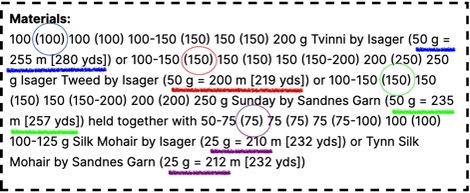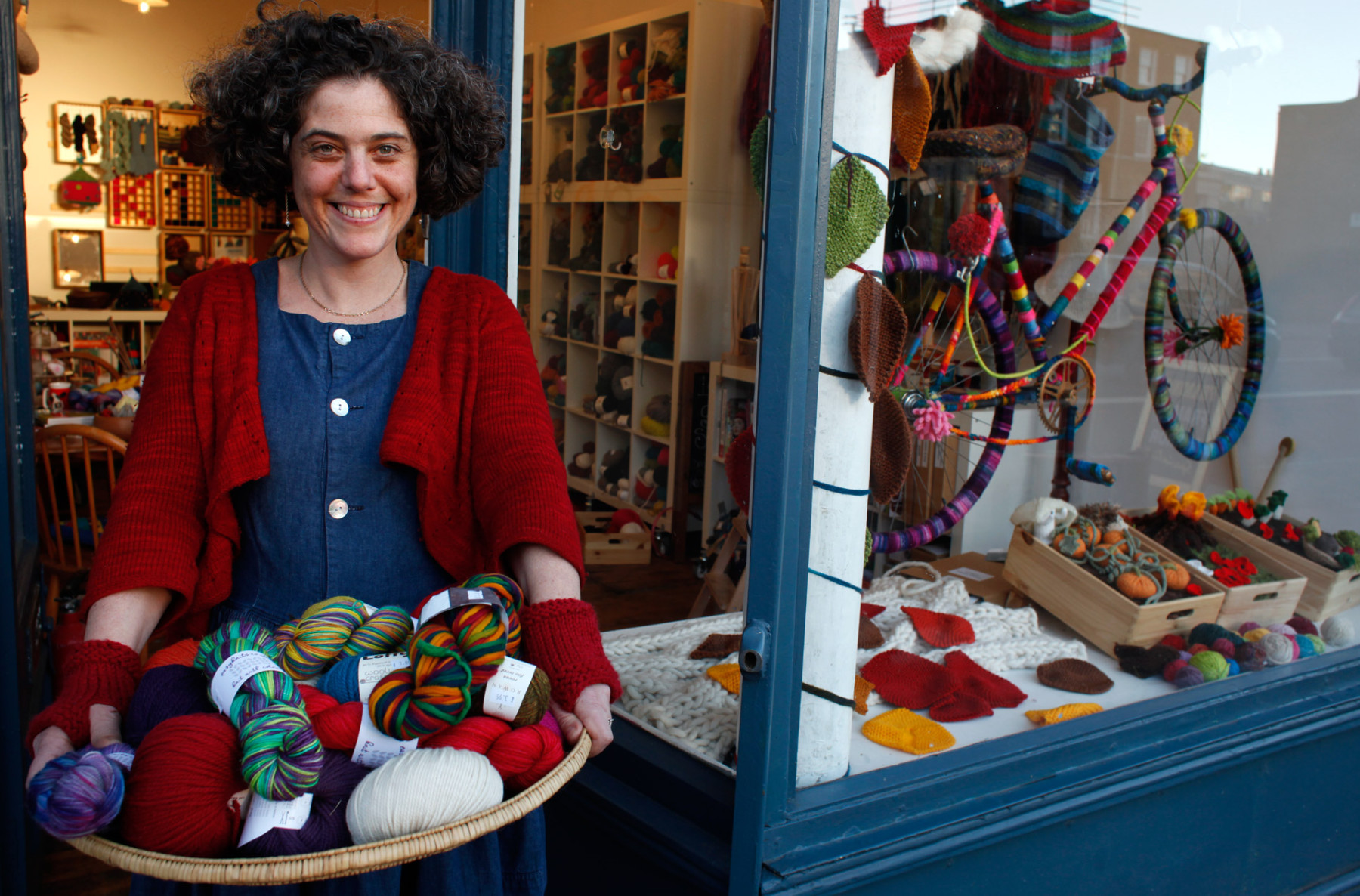Knitters count and they do it a lot: we count ourselves all around necks, yokes, bodies and sleeves, we count our way through elaborate lace repeats in shawls, we count our way up the crowns of hats, and down to the turning of heels, so why is it so confusing to count out how many balls of wool are needed for a pattern when we want to substitute in a different yarn? Why isn’t it just a case of working out which size you want to make and seeing how many balls of wool that size needs?
Because of two things:
- pattern designers don’t all agree about whether to describe amounts in lengths of yarn or weights of balls.
- different balls of yarn including ones which share the same gauge characteristics can have quite different meterage (i.e. length to weight ratios)
Welcome to the apples and pears comparison swamp. Yes it’s gloopy and sticky down here but we have no intention of leaving any of you behind. If you hold on tight and stay alert we will all get out of here without turning any of you into a crumble. We’re going to do this by working out the length that a pattern needs. Why? Because this is a reliable amount that shouldn’t change, regardless of which yarn you choose.
Let’s start with an easy one.
You want to make the Petite Knit Sophie Scarf but you don’t want to make it in the expensive cashmere that’s listed in the pattern. You’ve heard bad things about cashmere production and you’d rather knit with wool that you can feel a bit more sure of.
You’ve decided to make the second (larger) scarf size. So now we need to calculate how much you’ll need if you substitute in a different yarn.

This information tells us that the larger size scarf uses 28g of the cashmere yarn.
If we’re going to translate this into a number which will help us choose the right amount of a different yarn, the best way through is to convert 28g of Mondial Cashmere into meters. This is because the meters (length of yarn used) will be the same regardless of which brand or fibre or spin of yarn we choose.
To get there, we’re going to use this key piece of information about the recommended yarn: it comes in 25g balls of 115m.
Step 1
Work out how many meters there are in each gram of yarn by dividing length by weight:
115/25 = 4.6
This means we have 4.6m in every gram of cashmere yarn.
Now let’s take the total weight of cashmere yarn that the pattern says you need, and convert it into meters..
28g x 4.6m = 128.8m
Step 2
It’s time to choose which yarn you want to use instead. You have a look around a friendly wool shop in Clapton to see what yarns fit that brief and decide it will be more fun, affordable and ethical to make it one of the lovely colours of Cautiva from Wool Dreamers – an interesting mill in southern Spain that you recently saw on IG is working sustainably with local shepherds by making wool with fibre from local sheep. No badly treated goats or intensively farmed hillsides, or exploited cashmere combing workers. Now let’s see about how much Cautiva that’s going to need.
Each 50g ball of Cautiva has 170m, so 1 ball will be plenty.
I told you it was easy right? But what if we have a more elaborate pattern.
Petite Knit offers us a rich seam of confusing options to decipher. Here’s one of my (not) favourites from the Stockholm Slipover..

The pattern provides the weight of yarn balls for 3 alternative yarn options, all of which are designed to be worked at a standard DK gauge by holding a strand of any one of these 4ply woolly yarns together with a strand of silk mohair. I’m going to use the Sophie maths above to translate each one into meters..
100g of Tvinni with meterage of 255m/50g = 100 x (255/50) = 510m or..
150g of Isager Tweed with a meterage of 200m/50g = 150 x (200/50) = 600m or..
150g of Sandnes Sunday with a meterage of 235m/50g = 150 x (235/50) = 705m
And whichever one you pick needs to be held together with:
75g of silk mohair with a meterage of 212m/25g = 75 x (212/25) = 636m
Now that we’ve done all that maths, had a chance to lie down in a dark room, attend a gong bath and do some quiet yoga breathing, we’ve resolved to keep things simple, unfluffy and local and make the slipover using one strand of Sheepsoft by Laxtons as it comes from Yorkshire in just the colours we like and knits to a perfect DK gauge on its own.
Laxtons Sheepsoft comes in 100g skeins of 225m (and the nice lady in the wool shop is also offering to wind them if we ask nicely). Do we need 510m, 600m, 705m or 636m?
We go with the lowest number. Why? Because if we look at Petite Knit’s yarn quantities for the Stockholm slipover it’s clear that she is rounding up to the nearest whole ball of each alternative. All of them have enough meters for the slipover, which means that the difference between them is in how much you’ll have left over. So the meterage that I’m most interested in, is the lowest number – 510m.
So now it’s a case of seeing how many skeins of 225m Sheepsoft, I’ll need to get 510m, which looks like this..
510/225 = 2.27, or roughly two and a quarter skeins. That means either getting 3 whole skeins, or 2 skeins plus a quarter that you have leftover from another project.
So why doesn’t PK just give the precise meterage in the first place? That would make it much easier, less mathsy and possibly less wasteful to work things out – right?
Honestly I don’t know the answer to that question. But there’s a cup of tea and a slice of cake waiting here for the person who knows the answer and can persuade me and Brontë that it makes sense.

